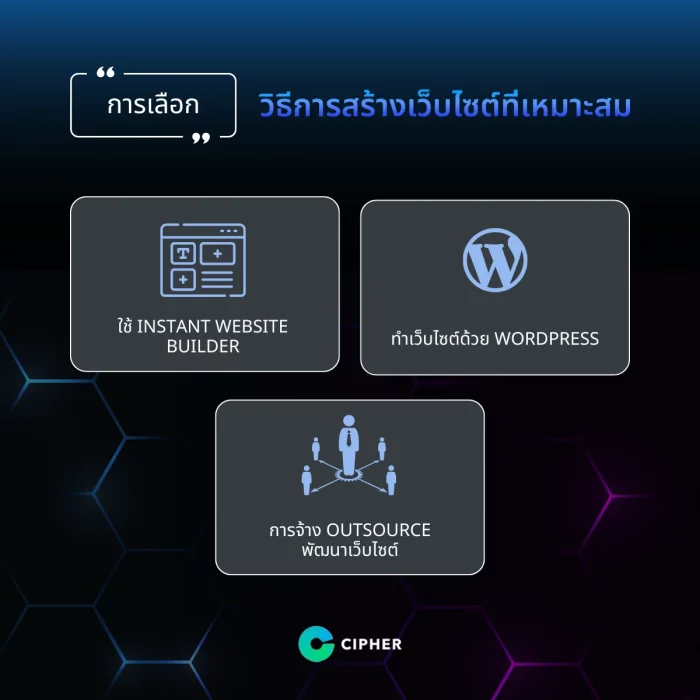Table of Contents
6 The process of planning to build a website to meet the business needs to be known. Anything?
Having their own website is an important channel in digital business, but many people are confused and don’t know how to start. That’s good because building a website has a lot of details to keep in mind, from planning, designing, designing, and development to making the website available for use.
Today we’re going to introduce a full-dimensional “Web Site Planning” process that will help you understand how to do web work systematically and apply it to your business. Whether you’re new or have some experience in web creation, this article will help you create a website efficiently. Let’s see what steps you can take!
Site Planning
Site design is an important process that helps to efficiently and to meet your objectives. Good site creation requires careful planning to achieve results that meet the needs of users and website owners.

Establish the primary objectives and objectives
The first step is to set clear goals as an important starting point in the website creation process. Targets may be selling products, providing information, or creating online communities. Clear goals will help determine the direction of website development in the next step.
Study and analyze website users.
In order to achieve success, it is essential to understand the target audience in terms of demographics, behavior, interests, and needs. This information helps to design the appropriate user experience.
Planning important systems and features
The main functions of the website should be in line with the user’s goals and needs. Planning the necessary functions will enable the creation of the website to meet the requirements of the website, and make the most cost-effective estimate of resources needed to develop and manage budgets.
Siteemap Design
Site maps are an important tool for organizing content and navigation structures. Good planning helps users easily and conveniently find information, which is a key factor in efficient web making.
lay out a structure and composition
Another important aspect of the site planning process is that the layout of components in the web page takes into account good design principles and ease of use. A good web page structure allows users to access information quickly and systematically in line with the goal of effective site design.
Choosing the appropriate website creation method
Once the site is planned, the next important step is to choose the appropriate method of site construction based on the requirements and characteristics of the site that will be built. The principles of consideration are as follows:

Use Instant Website Builder
Website Builder is an ideal choice for beginners who need a quick and easy way to create a website. These tools come with a ready-made template and a dragline interface, allowing them to design websites without the need for coding knowledge.
The advantage of the website builder is that there is a simple website development planning process suitable for small to medium-sized websites. However, there may be limitations in flexibility in customization and advanced features. Users should consider long-term requirements before choosing to use them.
Make a website with WordPress
WordPress is a highly popular web content management system for its flexibility and customization through plug-ins and themes. WordPress is ideal for those who want a balance between ease of use and customization.
WordPress website design and construction can be done either with a ready-made theme or with customized web design principles. The system is ideal for a wide range of websites, from personal blogs to large business sites.
outsource hiring, developing websites
outsource outsourcing is an ideal way for organizations that require highly complex or specialized Web sites. Professional development teams will oversee the entire Web build process, from demand analysis to site design and development.
The outsource site planning process requires clear communication between project owners and development teams to achieve results that meet their needs. Even if the cost is higher than other methods, the website is truly quality and meets the business requirements.
6 Web Design Phase
The planning process and the design principles of a good website should begin with clear planning and work with Developer to create a Web Design & Development to provide the desired functionality and results. There are 6 important steps that should be taken in order as follows:

1. Define concept and content clearly (Concept/ Content)
The first step in building a website needs to be to clearly define the concept and content of the website. It needs to know that the website has a purpose. What? Who’s the target group? And what kind of content do you want to offer to the next step of designing and building a website that meets the needs of your users?
2. Define the desired site structure (Sitemap)
The efficient way to create a website requires a good structure. Sitemap is designed to systematically map web pages, make them easy and convenient for users to access information, and make web creation as planned.
3. Provide a domain name for the website.
The web process requires the preparation of a short, easy-to-remember, and communicating domain name for your business or service. Choosing a good domain will make it easier for users to recognize websites and increase accessibility.
4. Place design to match (UX/UI Design)
The design process of the website must take into consideration both the User Experience (UX) and User Interface (UI) to make it easy for users to use, beautiful and satisfying their needs.
5. Choose a convenient way to create a website.
There are many different ways to create a website. Whether you use a website builder, CMS such as WordPress or self-coding, you have to choose the appropriate method for your ability and budget to efficiently develop the website.
6. Web Design for Responsive Web Design
Making a website supporting the display of all sizes of screens is important in modern design. Because users access the website through a variety of devices, Responsive design improves the user experience on all devices.
Conclusion
Building an efficient website requires careful planning, from targeting, design to Web availability. A good website creation process can save you time and budget and get a website that truly meets your business needs.
If you are looking for a CIPHER web design professional, consult and supervise your web creation, with an experienced team of professionals, we are ready to help your business move online confidently. Contact us today for advice and special offers for your web development!
Frequently Asked Questions
For brands or businesses that want to build their own website and look for more information about the site planning process, we have compiled common questions and answers to enable more efficient site planning.
Steps to create a website are: Anything?
- Choose a website format: you have to start with the process of planning a website and clearly define the purpose of the website, such as making a sales site, blogging or corporate website, and then choose the appropriate platform, such as WordPress, Shopify, or write your own code.
- Website Decoration: Design the theme and structure of the web page to be beautiful, easy to use, and to meet the target audience’s needs by taking into account the color, font, and proper layout of components, as well as supporting displays of all sizes.
- Create a Web Menu: Structure content and navigation menus for easy access, clear categorization, and appropriate sub-menus to ensure smooth website usage.
- Add information and photos: Create quality content, text, photos and multimedia with SEO in mind and make the content interesting to the reader.
- Check and add Social Networking: Test the website’s functionality, fix errors, and connect to social media to make it easier for users to share content and communicate with each other.
- Advertising and popularizing websites: Plan online marketing for SEO, social media marketing, email marketing and advertising through various channels to create awareness and attract visitors.
How many steps are there in the process of building a website?
The process of creating a website consists of 9 important steps as follows:
- Objective: Identify clear objectives, the process of planning an important website to communicate with. What? Who’s the target group? And they want the user to do it. What’s on the website?
- Choose a domain name and host: choose a recognizable, business-oriented website name and a reliable and stable hosting provider.
- Choose a platform: Consider choosing the right platform, such as WordPress, Shopify, or write your own code, taking into account the needs of the business.
- Structural Site Design: Plan the layout of menus and windows so that users can easily access information and have systematic connections.
- Web Design: Create an attractive, easy-to-use design with UI/UX principles and device-based displays.
- Create content and write articles: Create quality content that meets the needs of the target audience and update it regularly.
- Enhance SEO: Customize websites to rank among Google searches using appropriate keywords and make websites search engine-friendly.
- Publishing: Test all functionality before actual launch and plan for website publicity through various channels.
- Assessment and improvement: Monitor usage results through various analytical tools and continuously update the website.
What are the steps to create a website for online business?
- Strong branding: Develop a unique brand identity through website design that reflects the value and position of the business, as well as establish a clear brand communication strategy.
- Designing a good user experience: Design a website to be easy to use, have proper placement of components, and avoid excessive use of user-disruptive advertising.
- Creating valuable content: Develop both free and premium content to attract and maintain audiences with a focus on quality and consistency in updates.
- Increasing Web Access: Use effective SEO strategies in conjunction with social media marketing to create high-quality traffic.
- Building an online community: Develop a strong follower base through consistent engagement, meeting user needs, and creating valuable interactions.
- Sustainable Revenue: Planning to generate a variety of revenues, such as advertising space, product and service sales and public relations space rental, taking into account user experience.
- Analysis and Development: Use data analysis tools to understand user behavior and bring information to continuously update websites.
How important is Planning in website design? ?
Planning is the most important step in website design because it sets clear direction and goals, makes it systematic and efficient. At this stage, target groups, site objectives, content structures, and components are analyzed, and appropriate technology is selected.
Planning a good website will save development time and resources, reduce the risk of having to solve problems later, and get a website that truly meets the needs of users.





